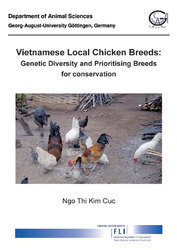| Fachbereiche | |
|---|---|
| Buchreihen (96) |
1330
|
| Geisteswissenschaften |
2305
|
| Naturwissenschaften |
5357
|
| Mathematik | 225 |
| Informatik | 314 |
| Physik | 976 |
| Chemie | 1354 |
| Geowissenschaften | 131 |
| Humanmedizin | 242 |
| Zahn-, Mund- und Kieferheilkunde | 10 |
| Veterinärmedizin | 100 |
| Pharmazie | 147 |
| Biologie | 830 |
| Biochemie, Molekularbiologie, Gentechnologie | 117 |
| Biophysik | 25 |
| Ernährungs- und Haushaltswissenschaften | 44 |
| Land- und Agrarwissenschaften | 996 |
| Forstwissenschaften | 201 |
| Gartenbauwissenschaft | 20 |
| Umweltforschung, Ökologie und Landespflege | 145 |
| Ingenieurwissenschaften |
1752
|
| Allgemein |
91
|
|
Leitlinien Unfallchirurgie
5. Auflage bestellen |
|
Erweiterte Suche
Vietnamese local chicken breeds
Genetic diversity and prioritising breeds for cvonservation
Ngo Thi Kim Cuc (Autor)Vorschau
Inhaltsverzeichnis, Datei (28 KB)
Leseprobe, Datei (57 KB)
The overall goal of this study was to characterize the genetic diversity of the Vietnamese
local chicken breeds and to identify population priorities for conservation. The specific
aims were 1) to assess and explain the population genetic structure of the Vietnamese
breeds, 2) to characterize the Vietnamese breeds in relation to the Chinese breeds and
wild chickens, 3) to estimate conservation potentials for conservation priorities of the
Vietnamese breeds, and 4) to define an optimal allocation of limited conservation funds
to them.
First genetic diversity within and between the Vietnamese breeds was analysed at the
autosomal level using 29 microsatellites. A total of 353 individuals of nine Vietnamese
local breeds and two breeds of Chinese origin were studied. The Vietnamese breeds were
sampled from the northern and southern parts of Vietnam while the two Chinese breeds
(NIAS Chinese breeds) have been kept at the National Institute of Animal Sciences,
Hanoi. The results revealed a high level of diversity within Vietnamese breeds. Analysing
the genetic structure using the software package STRUCTURE suggested an optimal
clustering at K = 6. These groups encompassed four homogeneous clusters, one formed
by the two Chinese breeds and the other three representing a single breed each: the
Mekong Delta breed Ac, the South Central Coast breed Choi, and the Red River Delta
breed Dong Tao. The six remaining breeds formed two additional admixed clusters. This
finding indicates that sub-structuring of the Vietnamese chicken breeds is related to their
geographical distribution. The two NIAS Chinese breeds are genetically distinct from the
Vietnamese breeds.
Mitochondrial DNA D-loop sequences were used to determine the degree of shared
mtDNA haplotypes between the studied breeds. A 455-bp fragment of the mtDNA Dloop
region was sequenced in 222 chickens of nine Vietnamese breeds and two NIAS
Chinese breeds. As reference, a skeleton was created based on chicken mtDNA sequences
taken from the Genbank which assigned clades to suggested regions of domestication in
chickens. Haplotypes of the nine Vietnamese and two NIAS Chinese breeds were aligned
together with these sequences. The mtDNA haplotypes formed eight clades. The majority
of individuals of the two NIAS Chinese breeds grouped together in one clade. Although
the Vietnamese breeds were distributed across all eight clades, most of them clustered in
three main clades originating from Yunnan, South and Southwest China and/or
surrounding regions.
The differentiation of Vietnamese breeds from Chinese chickens was characterised. For
this, as reference, data of 14 indigenous breeds from China (Reference Chinese breeds)
and three Red Jungle Fowl populations (Gallus gallus gallus and Gallus gallus
spadiceus) genotyped at the same microsatellite loci in a previous study were included.
Analysing the genetic structure indicated that the Vietnamese breeds formed a
homogeneous group separated from the other breeds (except for the Chinese Chahua
breed). This finding provides additional evidence that the Vietnamese gene pool is
genetically different from the Chinese gene pool even when a wider range of breeds is
considered. Another analysis was also used to find the degree of uniqueness of the
Vietnamese breeds relative to a set of three Red Jungle fowl populations. Compared to
the reference Chinese breeds, the contribution of the Vietnamese breeds to the set of Red
Jungle Fowl populations is lower. This suggests that the Vietnamese breeds are more
closely related to the Red Jungle fowl populations than the reference Chinese breeds.
The second objective of this thesis was to estimate the conservation potential of the
Vietnamese breeds and to derive optimal allocation of conservation funds to maximize
genetic diversity conserved between these breeds. The Weitzman approach for assessing
alternative conservation strategies for genetic diversity between breeds was used. The
approach combines genetic diversity assessed at the molecular level and extinction
probabilities estimated by socio-economic factors to derive conservation priorities of
breeds based on their conservation potential. To investigate an optimal allocation of
conservation funds, three different models were applied. These models reflect the range
of possible functions between costs and effects in typical conservation situations. Under
the assumptions made it is expected that half of the genetic diversity of the Vietnamese
breeds will be lost within the next 30–50 years if no conservation efforts are taken.
Conservation potential of the Vietnamese chicken breeds varies considerably. The
optimum conservation strategy to maximise genetic diversity between the Vietnamese
breeds should prioritize the breeds with the highest conservation potential. Population
priorities for allocation of conservation funds to the Vietnamese breeds do not depend on
which cost model was used. The three local breeds Te, Dong Tao and Ac have the highest
conservation potential and should be the prime candidates for conservation programs.
| ISBN-13 (Printausgabe) | 386955343X |
| ISBN-13 (Printausgabe) | 9783869553436 |
| ISBN-13 (E-Book) | 9783736933439 |
| Sprache | Englisch |
| Seitenanzahl | 126 |
| Umschlagkaschierung | glänzend |
| Auflage | 1 Aufl. |
| Band | 0 |
| Erscheinungsort | Göttingen |
| Promotionsort | Universität Göttingen |
| Erscheinungsdatum | 25.05.2010 |
| Allgemeine Einordnung | Dissertation |
| Fachbereiche |
Land- und Agrarwissenschaften
|








